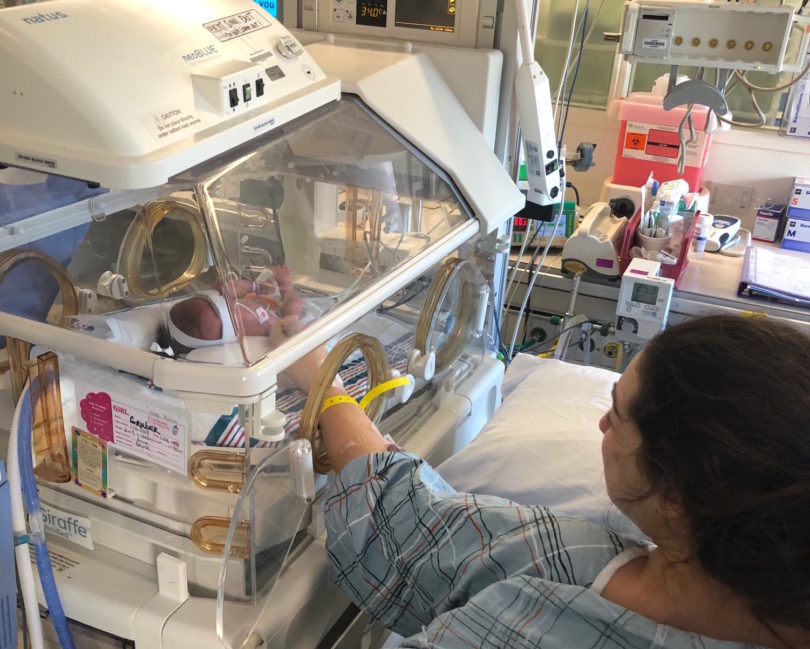Surviving my placenta accreta pregnancy forever changed me.
If you don’t already know what Placenta Accreta Ultrasound is, don’t worry — few people do. If you asked just about anyone 20 years ago or more, they most likely would’ve given you a totally bewildered stare. The term has only recently garnered media attention to some degree thanks to a few high profile cases. I’m going to share my very personal pregnancy story with you, and it’ll probably sound like science fiction, but it’s real, on the rise, and could happen to you. Here’s what you need to know.
The risk factors are SUPER common and may surprise you
If you’re wondering why you even have a placenta accreta or how you ended up at risk, the jury is still out on all the reasons — but for now, the medical community is sure that prior c-sections will increase your risk dramatically. In fact, depending on who you speak to, some say that by the time you’re on your fourth or fifth c-section, you’re almost guaranteed to develop an accreta. Nobody talks about that when you’re delivering your second or third child though, and for some reason, docs don’t really even bring this up till it’s too late. Other risk factors include having had uterine devices like IUDs.
You can read about my experience with Paragard after my third c-section here. I wrote that when I had no idea that the device actually left me at greater risk for a life-threatening placenta accreta. Other risk factors seem to include IVF and frozen embryo transfers, smoking, and “advanced” maternal age, which hasn’t quite been explained yet. In fact, not much of anything in terms of placenta accreta has been explained in a formal, medical way to anyone — and that’s because until very recently, this condition was so minute in the scheme of deliveries that it didn’t garner much attention at all.
The CDC reported nearly 7% of all American women 15-44 current have IUD devices in place, making the portion of the population at risk for developing a life-changing placenta accreta diagnosis is literally in the millions. In my case, my placenta accreta diagnosis came after four prior c-section deliveries as well a terrible IUD experience.
Placenta accreta has three different variations
Placenta accreta is defined by the Mayo Clinic as, “a serious pregnancy condition that occurs when the placenta grows too deeply into the uterine wall. Typically, the placenta detaches from the uterine wall after childbirth. With placenta accreta, part or all of the placenta remains attached. This can cause severe blood loss after delivery.” What people don’t realize is that this accreta term is really an umbrella for a variety of associated conditions including increta, where the placenta grows deeper into the uterine wall, and placenta percreta, where the placenta essentially grows beyond the uterine wall, through the other side, and does a hefty job of attacking other nearby organs. Typically the bladder is the first target, as it was in my case.
It’s common for a doctor to say you have a “suspected” accreta, that turns out to be a placenta increta or percreta at the time of delivery. One of the hallmark signs of placenta accreta is a “Swiss cheese” like appearance, like mine.
Some women with placenta previa claim theirs can actually migrate, or move to less precarious positions, by week 30 or so. It seems that placenta accreta ruins these chances because of the way it attaches to the uterine wall, so don’t count on migration as your saving grace.
Placent accreta is often associated with placenta previa

Credit: RNpedia
Placenta previa is a condition where the placenta adheres to the lower portion of the uterus rather than the top or side areas. Placenta previa is dangerous on its own, often causing severe bleeding before and during the time of delivery. Adding a placenta accreta diagnosis to the mix is basically fuel on the danger fire. You can read about that here, but basically, if you’ve ever had a c-section, abortion, or uterine device and have been diagnosed with a placenta previa of any grade, you should ask your OB for a higher level scan to assess the possibility of any degree of accreta.
The key to surviving placenta accreta, increta, or percreta is early detection. Usually a routine 20-week ultrasound will at least detect a placenta previa.
Why aren’t people talking about it?
Household names like Kim Kardasian have survived placenta accreta — but her diagnosis was made after her first live birth. She went on to conceive more children through IVF and surrogacy. Beyond that, there seems to be a sense of shame. Somehow there’s just not enough public information. The general treatment plans aren’t strong enough or streamlined, and women just don’t feel comfident enough in their realities and strength to make accreta, increta, and percreta as commonly known as it is commonly felt.
With statistics showing incidences of accreta variations as high as 1 in 272 pregnancies, that’s alarming.
Get better doctors immediately
Do not even think about seeing your placenta accreta diagnosis through to delivery with a regular OBGYN. I should note that I’m not a doctor, but as a survivor of placenta percreta I can tell you wholeheartedly the level of expertise you surround yourself with is your best chance at surviving, and your baby’s. Call your insurance immediately to see which high risk OBGYN and maternal-fetal medicine specialists are covered under your plan.
Any doctor you choose needs to be associated with a level 3 NICU hospital or better. If you can get a doctor affiliated with a level 4 NICU, even better — but they’re rare. Level 3 NICUs are equipped to handle babies born before 32 weeks gestation, with critical illnesses, and other complications like traumatic births. This brings me to my next issue — preparing for a preemie.
Expect to bleed
One of the hallmark signs of placenta previa is bleeding for no apparent reason when you’re pregnant. When you’re faced with an accreta diagnosis, this likelihood becomes even stronger and more dangerous. When you deliver with accreta, you’re going need donor blood on hand in the operating room. Some women bleed so profusely during their c-sections that docs either can’t control it, don’t have faith in your body recover without donor blood products, or you will simply die if you don’t receive them. In my case, my entire blood volume had to be transfused. If you have a rare blood type, hold a blood donation event with your local Red Cross, hospital, or community center. Even if you don’t collect the blood YOU need, you know you’ll be helping save other lives. Good karma has to count for something.
Can’t receive transfusions? Tell your high risk OBGYN or MFM to call in a cell saver device ahead of your surgery. I wish I had one for my own. Blood transfusions are no joke, and the side effects are long-lasting — I’ll talk about that more another time though. Do not gloss over this, because 7% of women die from placenta accreta from blood loss alone.
Does accreta always mean hysterectomy?
No, not always, but the facts seem stark. Delivering with placenta accreta means a c-section, and that c-section is typically performed vertically. Some vertical c-sections use a vertical cut on the inside of the uterus only, so you’ll still wear a bikini without people noticing. Other c-sections, however, are done classically, top to bottom. Only small or focal accreta deliveries have a shot at uterine conservation.
My own surgeon had told me early in my diagnosis that I wouldn’t survive my delivery without a partial hysterectomy. There just wouldn’t be enough time try to surgically remove my cancer-like placenta from the walls of my uterus and the other nearby organs it began to invade, like my bladder. As it was, even with the classical c-section I had, I bled out. Percreta patients like me also see bladder repairs, sometimes bowel removal, and ongoing pelvic floor issues.
My ovaries were left in tact so I could produce all my usual hormones, but I lost my cervix, uterus, fallopian tubes, and part of my bladder. I now have a scar from my original bikini c-section scar to just beyond my navel. It was closed with surgical staples, and yes, it was infinitely more painful than a regular c-section incision. But you heal, because there’s a baby who needs you more than you need the belly you used to have.
Your diagnosis and treatment will be between you and your doctor, but go into your next appointment knowing the possibility of a partial hysterectomy is strong.
Your baby WILL be born early
I’ve spoken to literally thousands of accreta, increta, and percreta survivor moms now, and they all say the same thing about due dates. Scrap your expected due date. All their babies were born significantly earlier than 40 weeks if they were diagnosed with a degree of placenta accreta. That includes mine, who was born about two months early. If you’re thinking “oh, a few weeks is okay, my friend from work had hers at 35 weeks and they were fine,” that’s great — and maybe true, but the general recommendation for doctors treating placenta accreta pregnancies is to deliver at 34 weeks gestation on the dot. The problem is, many women like me, never even make it that far.
You don’t know if you’re going to be the one lucky enough to make it all the way to 34 weeks, where expected NICU stays can range anywhere from one to three weeks. You also don’t knowif you’ll have an emergency surgery to deliver your baby the minute you hit your third trimester. Prepare for all possible scenarios, because anyone who says you can completely rule out the NICU with an accreta diagnosis is lying. In my case, my daughter was born at 3 pounds 9 ounces, and required 40 nights in her level 3 NICU.
Don’t have sex, work out, or run every errand you used to
There are diverse opinions on total bed rest, supervised best rest at the hospital, or just pelvic rest. At a minimum, pelvic rest means no sex, nothing in your vagina, and no orgasms. I know — it seems unfair, especially with all that stress, but orgasms cause uterine contractions, and that’s the last thing you need right now. An orgasm could literally cause you to bleed out so quickly you die before an ambulance can get to you. Is it hard? Completely. Is it worth abstaining? Only if you like being here on this Earth and giving your baby a fighting chance, too.
Does diet matter?
I can’t find any official literature on diet affecting the outcome of placenta accreta rates, sadly. The research just doesn’t seem to exist yet. That said, every doctor and nurse I spoke to at Mt. Sinai Hospital in New York, the place that let me hang on to life a bit longer, had the same advice. Eat lots of lean protein, low or no sodium foods, and whole low carb options.
My favorite nurse told me I’d need to add protein to just about everything I was eating. Why? To give my baby even a few extra ounces of body weight because she’d be missing the vital last few weeks of fat-gaining time on the inside. As gross as they were, I’m pretty sure all those hard boiled eggs and bunless burgers helped. My daughter was born a few ounces beyond similar babies of her gestation. As any NICU mom will tell you, every ounce is a miracle. She also survived when her first NICU roommate, another accreta baby, didn’t make it.
You NEED a support network
No, your best friend since childhood isn’t going to understand. Your significant other will not understand. Fibroids are not the same, even if they result in bleeding and hysterectomy. A near death experience is not the same. Nobody on the planet can understand the feeling of the most precious part of yourself, your baby, living under constant threat while you’re fighting for your own life unless they’ve been there. Your loved ones will do their best to understand, but hopefully they never will. That’s why finding a local accreta support group chapter is essential for your emotional survival. The way you come out of this delivery will forever change the way you see everyone around you, so prepare for that as well. I found a lot of comfort, strength, and information in this Facebook group.
Do you believe in something? Now is the time.
Get busy praying, because with so many moving factors and parts, you can’t control 100% of your fate. Make your way back to whatever gives you a sense of purpose in this universe, because you’ll need it. Meditate, pray, and express gratitude for each day. Now let’s talk about the elephant in the room.
Death
Is placenta accreta deadly? That depends on who you ask. I have personally known more than a few women who haven’t lived to tell their stories. I cry just thinking about it. One of my own friends lost her week-old baby. She couldn’t say goodbye because she was still in a medically-induced coma when he passed in the NICU.
Maternal death statistics fall at about 14%, but I haven’t found any official statistics for infant death from accreta. Every accreta mom should have a Living Will in place (a fellow mom and elected judge suggested this site for those low on time and cash). Even if your own diagnosis is pretty mild, it can’t hurt to have a living will. Every accreta survivor I’ve known has spent some time in a medically-induced coma in the ICU post-op. Unfortunately, you may not have the chance to spell out your wishes after the surgery.
This post was purely what I wish I had known during my own placenta accreta pregnancy. I am not a doctor, so please consult your own for treatment.
Love this article? For more beauty, style, travel, and trending topics check out The Luxury Spot on Facebook. Like us and we’ll love you back!













